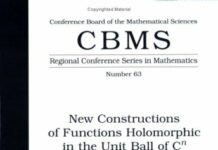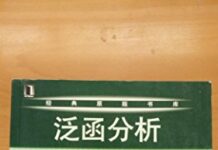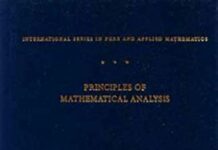
Ebook Info
- Published: 2017
- Number of pages: 305 pages
- Format: PDF
- File Size: 8.37 MB
- Authors: Walter Rudin
Description
Written by a master mathematical expositor, this classic text reflects the results of the intense period of research and development in the area of Fourier analysis in the decade preceding its first publication in 1962. The enduringly relevant treatment is geared toward advanced undergraduate and graduate students and has served as a fundamental resource for more than five decades.The self-contained text opens with an overview of the basic theorems of Fourier analysis and the structure of locally compact Abelian groups. Subsequent chapters explore idempotent measures, homomorphisms of group algebras, measures and Fourier transforms on thin sets, functions of Fourier transforms, closed ideals in L1(G), Fourier analysis on ordered groups, and closed subalgebras of L1(G). Helpful Appendixes contain background information on topology and topological groups, Banach spaces and algebras, and measure theory.
User’s Reviews
Reviews from Amazon users which were colected at the time this book was published on the website:
⭐Rudin is known (in my era by my undergraduate professors) as having written (a) gospels of Analysis (Real and Complex Analysis – Papa Rudin – ‘entrance level first year graduate pure mathematics at UCDavis in 1993’) (Principles of … – Baby Rudin – To enter UCDavis in ’93 Papa and Baby were ‘must reads’ as they didn’t teach ANY Topology course in California State University Stanislaus [1989-1992] other than what one would find in an upper division Analysis course taught with a much lesser book (if it had one at all) UC used Baby for undergraduate classes in Analysis at the time) and I don’t consider this book to be ‘unexceptional material from Rudin’ – Upon reading some of this book, within the last five years or so, I got side-tracked on one of his (potentially still unsolved problems) that was of interest to me and an advisor (from CSUS who doesn’t think he could ever do an unsolved problem – he’s probably solved many ‘unsolved problems’ in his fields, accidentally, on purpose) – I don’t have similar to compare it with right now….
⭐The kindle type face is wonderful. This is rare. The print in kindle math books is often horrible, but Fourier Analysis on Groups prints very well on tablets and even on my little kindle paper white.
⭐I always liked this book. It gives a pretty clean introduction to a very rich subject.
⭐This is a classic work in harmonic analysis, which is difficult to find in bookstores. I was very pleased with the condition of the book, and with my ability to acquire it at all.
⭐Rudin is a precise writer and has a good sense for how to organize material. He avoids piling up definitions and then proving a stream of theorems. It would be silly to come to this book without great familiarity with both measure theory and commutative Banach algebras. One should read the material in Rudin’s “Functional Analysis” on the Gelfand transform before reading “Fourier Analysis on Groups”. If you are comfortable with that, then you will be able to follow the proofs and appreciate the material in this book. (You would also benefit from first reading chapter 1 of Rudin’s “Functional Analysis”, on topological vector spaces.)The world would be done a favor if a new edition of the book were published, with light corrections done throughout it but with no additions. (Examples of corrections: on p. 16 there is a reference to appendix E6, which should be to E3; Theorem 2.7.2 has a misspelling; on p. 233, L^1(S) is a subalgebra of L^1(G); on p. 234 the measure mu should be on the dual group not G) The first two chapters of the book are worth reading by anyone who does harmonic analysis, while the remaining chapters are specialized. Chapter 5 is probably the best place in the literature to learn about Sidon sets. Another book with a large intersection of material is Folland’s “Abstract Harmonic Analysis”.Some changes I would like made are the following. 1) As far as I can tell there is a mistake in the proof of Theorem 1.2.2: the continuous version of phi that is chosen depends on f, at least as priori, but is then applied to translates of f. This can be worked around by talking about almost every element in the product space G x G.2) It would be worth proving that the Fourier transform of an L^1 function vanishes at infinity. (For R^n this is the Riemann-Lebesgue lemma, but for LCA groups, including R^n, it doesn’t need to be proved by approximating using differentiable functions like the Riemann-Lebesgue lemma is usually proved.) Rudin refers to the Gelfand transform and then merely asserts this to be true in that setting.3) In the proof of Bochner’s theorem on p. 21, Rudin states that the total variation norm of mu obtained from the Riesz representation theorem is less than or equal to 1, but later uses the fact that it is equal to 1. It’s essential that the total variation is norm is equal to 1 to prove that the measure is positive.
⭐A very good book.
⭐ok
Keywords
Free Download Fourier Analysis on Groups (Dover Books on Mathematics) in PDF format
Fourier Analysis on Groups (Dover Books on Mathematics) PDF Free Download
Download Fourier Analysis on Groups (Dover Books on Mathematics) 2017 PDF Free
Fourier Analysis on Groups (Dover Books on Mathematics) 2017 PDF Free Download
Download Fourier Analysis on Groups (Dover Books on Mathematics) PDF
Free Download Ebook Fourier Analysis on Groups (Dover Books on Mathematics)




